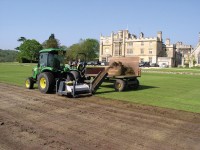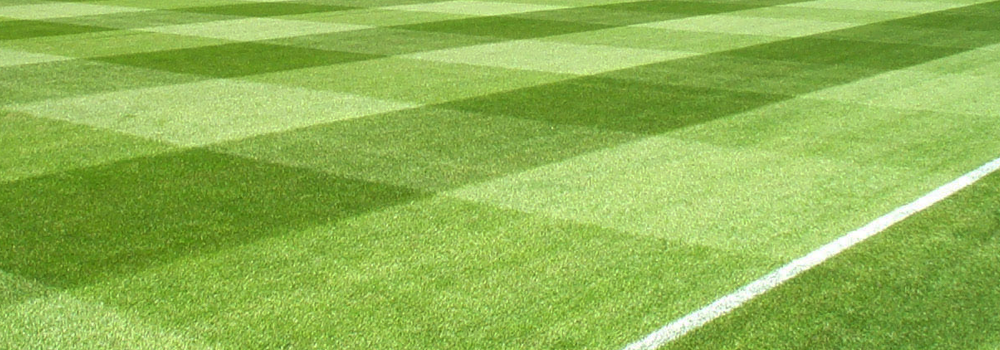
Rugby league clubs should continue with regular mowing of the sward to help promote tillering, mowing the grass at least twice a week; or more if you have the resources. A cylinder mower will provide the best results, cutting in a different direction each time.
Key Tasks for May
Renovations

Scarifying
Spiking
Fertilising
Seeding
Topdressing
If the list above is taken as a sequence of events, then you won't go far wrong with your renovation, though you may need to give some further attention to goalmouths and the centre circle.
Scarifying: clean out the surface, removing the remnants of old divots and to get rid of the build up of dead organic matter accumulated over the winter months.
Reduce the height of cut before scarifying. This will not only help your grass to establish better, but will help your machinery to carry out the work without struggling.
A tractor drawn rake, followed by a box mower is probably the most traditional method and within the means of most clubs and schools.
A collecting flail mower, with scarifying tines fitted, will allow the job to be completed in one operation. This method can be advantageous as the tines leave a grooved surface ideal for ensuring grass seed is buried just beneath the soil surface and in contact with the soil.
Whichever method you use, you will be aiming to achieve a surface that is short and clean with a finished mown height of 13mm to 20mm that will give your grass seedlings time to grow and establish without competing too much from the existing grasses.
For those with available finance, Koroing is extremely efficient at removing the top organic layer of the pitch. However, you will effectively be starting again with a newly sown surface so your seeding rates will need to be higher.
Spiking: relieving compaction is important, and spiking as deeply as possible - to a depth of 250-300mm is advisable. There are a number of different machines that can achieve this depth. Remember to check the depth of existing under soil drainage or soil heating before carrying out deep spiking.
Pay particular attention to heavy wear areas, including spectator areas.
Fertilising: A good pre-seeding fertiliser - typically one low in nitrogen and high in phosphorus and potash - will provide the young seedling with the essential nutrients to root quickly and to resist disease. This should be worked into the surface, brushed or dragmatted in. Water in if rain is not expected.
Seeding: Use a good quality rye grass seed mixture. New seed is important as old seed is unlikely to germinate as quickly or as lushly as new seed.
An early start fertiliser should be applied at this stage, which will help provide good grass recovery and the establishment of young grass seedlings, something like a 9:7:7 would be ideal, but should be in line with your soil analysis.
Oversow at the rate of 20 to 35g/m2. Keep some seed in reserve to oversow any thin areas later on. The important thing is to get good seed to soil contact to ensure good germination.
Monitor the progress/success of your renovations and oversow any thin areas to ensure that you have the best opportunity for the grass to be strong with good coverage for the start of the next season.
A slow release fertiliser can be applied later in the month to take the grass through June and July.
Topdressing: Choose a topdressing compatible with your current rootzone. This may typically be a medium to fine sand and of a quantity of 60 to 80 tonnes per pitch.
If you are using a general topdressing of 70/30, note that this could have a high clay content, despite the high percentage of sand, which could give you some problems later. It would be wise to ensure you know what is being supplied.
If you cannot afford to topdress, consider hollow coring, recycling them by breaking them up and dragmatting them back into the surface. If the construction of your pitch is a sand slit system, then topdressing regularly with compatible sand will be required to ensure that the slits do not become capped over.
Topdressing performs two important functions; it covers the grass seed to provide good soil to seed contact and will ensure good germination of an expensive resource i.e. seed. Secondly, it helps to restore surface levels.
Low areas in the pitch can be concentrated on. Minor dips and hollows that collect water, noted during the winter, can be further spiked. A slightly heavier topdressing for these areas will help to raise levels, though be careful to ensure the topdressing is worked into the holes and into the base of the sward. The topdressing should not be thick and left covering the top of the grass, as this will only lead to a weakened sward. Repeat the operation if necessary and check with a straight edge.
High wear areas: Wear can range from minimal, with some pitches sustaining little loss of grass in the goalmouths, to a strip running the whole length of the pitch completely devoid of grass cover.
Some areas may even have lost grass cover and soil, where the soil has migrated out of the area. In these areas, it is important they receive more concentrated effort to relieve compaction and to bring the surface levels back, by importing and incorporating new material compatible to your native soil.
In some instances, you may consider turfing, though this is expensive. You will need to give the turf time to establish in order to stop it getting kicked out.
Rugby League General Maintenance
- Continue brushing to keep the air circulating around the base of the plant, removing early morning dew and controlling disease
- Mow regularly at your preferred cutting height to ensure a good sward density
- Verticut to clean out lateral growth and aid air circulation
- Continue spiking when the conditions are right - alternating between surface and deep with occasional slitting
- Linemarking; “measure twice: mark once” is a good tip to take on board when marking out new pitches
- Make sure you have enough linemarking material for the season
- Applying a spring/summer N P K fertiliser to maintain grass colour and vigour
- Do not apply fertiliser during drought periods, unless you have the means to water in
- Avoid the use of fertilisers with a high salt content, as this draws moisture from the plant. Use of liquid fertilisers are less likely to scorch grass, but may still need to be watered in
- Consider, as an alternative, applications of seaweed or amino bio stimulants which have proved beneficial in helping grass through stressful periods. Another option is calcium; an important ingredient for giving the plant rigidity and regulating root and shoot growth
- If you are unable to provide irrigation to the whole pitch, then at least you should try and ensure adequate watering of the goalmouth and centre circle areas




Renovations
For anyone aiming to undertake end of season renovations during May, then the following strategies will assist seed establishment when applied as part of a spoon feeding, little and often strategy. Plants require adequate nutrition; excess is pure wastage and can do more harm than good.
Humates – stimulate auxin activity for root development and efficiently carry nutrients into the plant through roots and leaves, especially when applied as a liquid. Also provides nutrient and bacteria holding sites within the soil.
SeaWeed – chelates nutrients, provides a food source for plant-associating beneficial bacteria, stimulates auxin like activity.
Carbon – most often in the form of sugars, carbon facilitates a balancing of the carbon to nitrogen ratio which is essential for the healthy function of plants and microbes. If adequate carbon is available, plant and soil life can uptake more nitrogen, optimising the efficacy of fertiliser applications and supporting increasing populations.
Urea – as the amine form of nitrogen, urea is the fastest to be absorbed into plant tissue; foliar applications will be absorbed within 12-24 hours and utilised quickly by the plant. It is important to not wash off applications with irrigation in the time frame.
Phosphite – as a simpler form of phosphorous; a high quality phosphite which includes potassium is a significant driver of root development.
Nutrition
Whilst conditions remain unfavourable to granular applications, it is liquid foliar applications which are more likely to elicit a response form the plant, particularly when warmer spells of weather are forecast. Adding a small quantity (50 ml per 100 l tank volume) of a high quality liquid humate, such as Maxwell HumiMax, will further chelate the fertiliser, enabling it to pass into the plant leaf more readily for increased absorption and uptake efficiency.
Potassium is a plant nutrient traditionally favoured for autumn winter applications; however, potassium is absolutely critical to the efficient operation of plant stomata, the pores on a leaf’s surface which open and close in response to water demand. For this reason, a steady adequate supply of potassium during the spring and summer helps grass plants to better regulate water usage, increasing resistance to drought pressure.
Research is also increasingly understanding the importance of silicon applications as a preventative nutrient, which will strengthen plants resilience to a range of environmental and pest stresses.
Seaweed is another vital tool in the armoury when it comes to improving uptake of fertilisers and helping plants to resist stress, which should be regularly applied to all turf areas.
Wetting Agents
Utilisation of a penetrant and polymer wetting agent programme, which will drive water away from surfaces and into rootzones, where it can subsequently be stored more efficiently to be utilised by the plant, is a sound strategy for the majority of sports turf locations. Research the market and invest in high quality solutions. Prevention of dry patch with applications prior to symptoms is the most effective strategy.
Herbicides
Traditionally, the end of May presents a good time to spray for weeds in turf areas, applying herbicides immediately prior to, or during, periods of strong active growth. Again, adding a small amount of a liquid humate (50 ml per 100 l tank volume) will significantly aid herbicide uptake and efficacy.

As soils warm up, there may be some symptoms of plant parasitic nematode activity. There are two categories of nematode which will infect grass plants; Ectoparasitic which migrate along the outside of roots and feed accordingly on root cells and Endoparasitic nematodes which enter the root tissue and feed on the plants in these areas.
Be vigilant for the following symptoms:
• Yellowing and thinning of the turf
• Reduced turf vigour
• Premature wilt
• Turfgrass that is slow to recover from stress
• Turfgrass that does not respond to fertilisation
There are no legal chemical treatments; with entomopathogenic nematodes providing the only authorised cure. This situation is not going to change, but nematodes can be utilised successfully when applied correctly as part of a multi-faceted integrated approach. In the face of upcoming and projected further restrictions in other similar areas of the industry, there are a number of lessons to be learned from the withdrawal of insecticides within the sports turf industry. Now is a good time to reflect and prepare by seeking out avenues to embark on facing the upcoming challenges from the position of enhanced knowledge, understanding and proactive preparation.
Microdochium patch may also pop up as temperatures increase, particularly if the warmth occurs in conjunction with humidity and moisture on the leaf for prolonged periods. Systemic fungicides can be considered but only as a last option. IF grass is growing well and then the disease may well just bubble under the surface and the grass will outgrow it.
Please note: More information on these and many others can be found here: https://www.pitchcare.com/useful/diseases.php
Any machinery needed for the end of season renovations should have been booked in by now, unless you are planning to bring in a contractor.

Delegates attending the Winter Sports Pitch Maintenance course and using the accompanying manual will be able to develop their own skills, working knowledge and expertise, by understanding the method of instruction and the maintenance principles it sets out.
We are pleased to announce the launch an online version of this course, which means it can be undertaken in your own time and at home. More details of the online course can be found here - Winter Sports Pitch Maintenance (Rugby & Football)
Delegates attending the Winter Sports Pitch Maintenance course or using the online version, and using the accompanying manual, will be able to develop their own skills, working knowledge and expertise, by understanding the method of instruction and the maintenance principles it sets out.
Included in the Course Manual, there are working diaries showing the range of tasks needed to be accomplished each month. The Course Manual is available for purchase separately.
In addition, we are able to arrange courses to be delivered on site to groups of 6 – 10 people. Email Chris Johnson for information.
Other courses available include:
Linemarking
Safe Use of Pesticides (PA courses)
Pedestrian operated mowers
Hedgecutters
Brushcutters/strimmers
Toolbox Training
Manual Handling
Articles and Forum discussions you may find useful:


